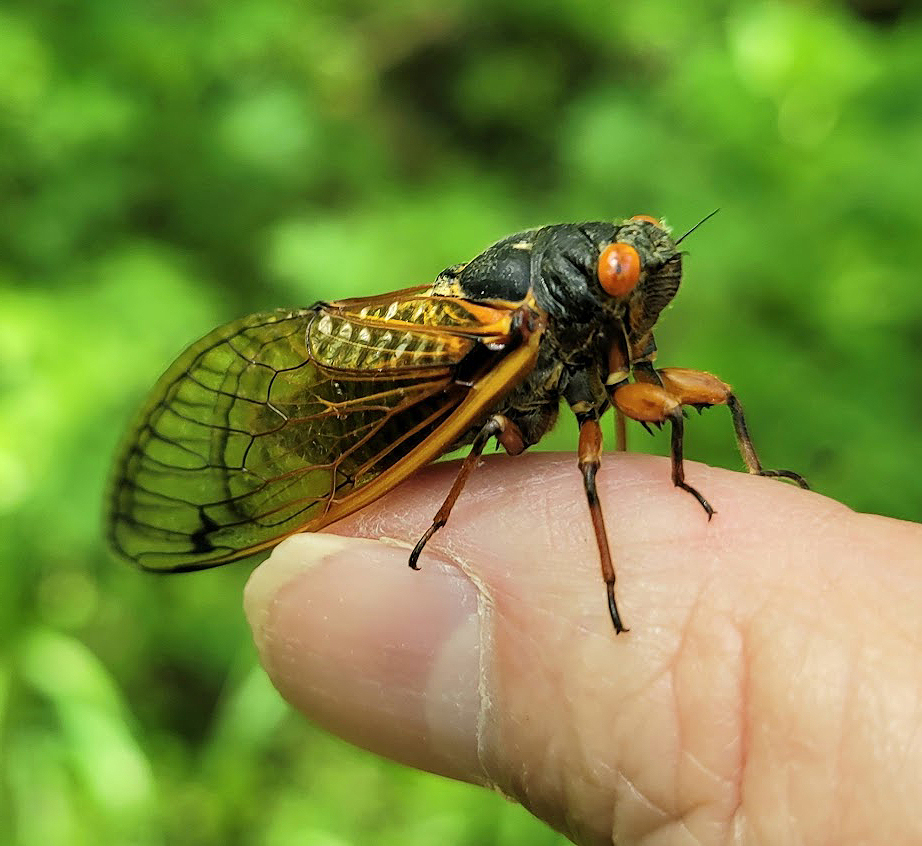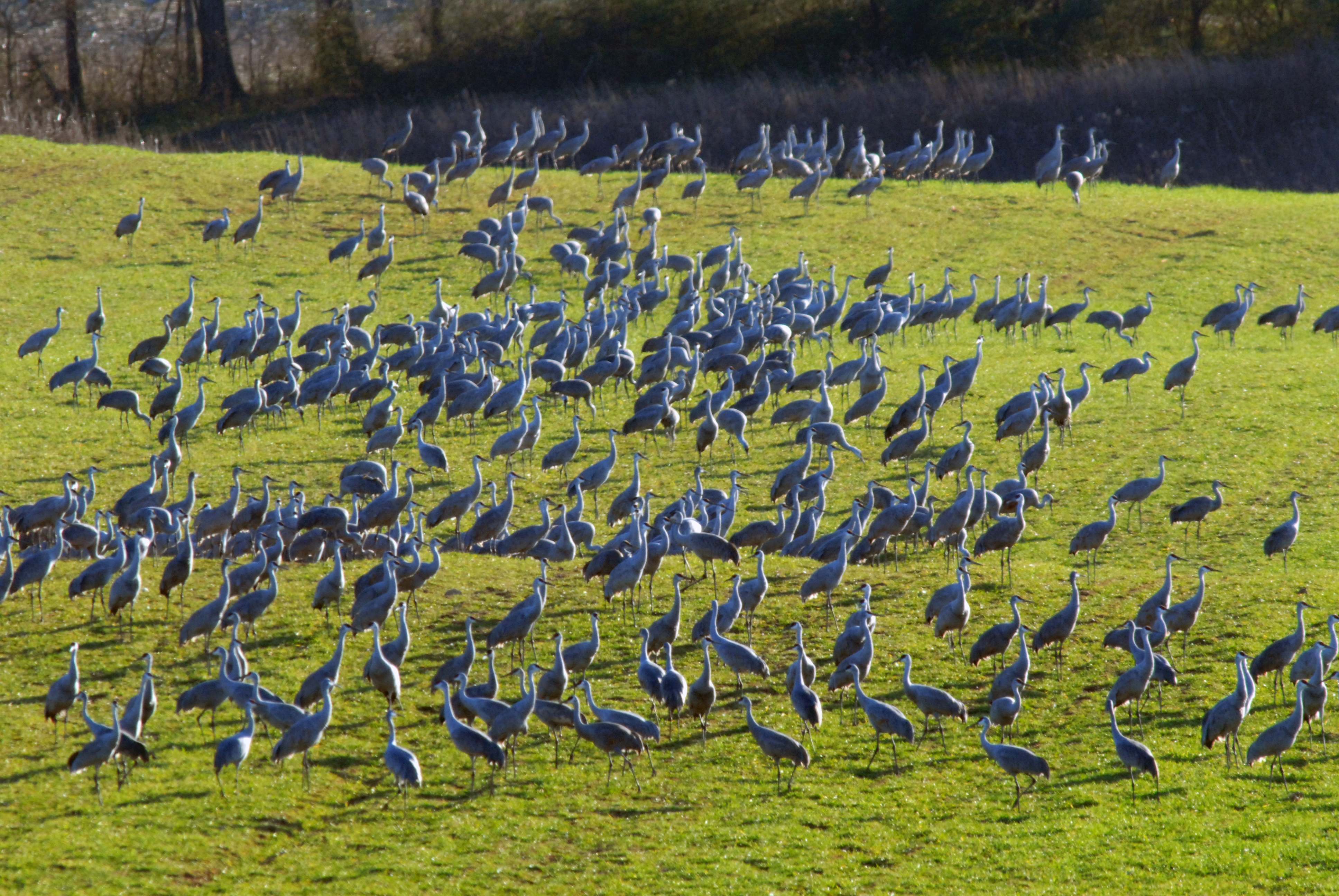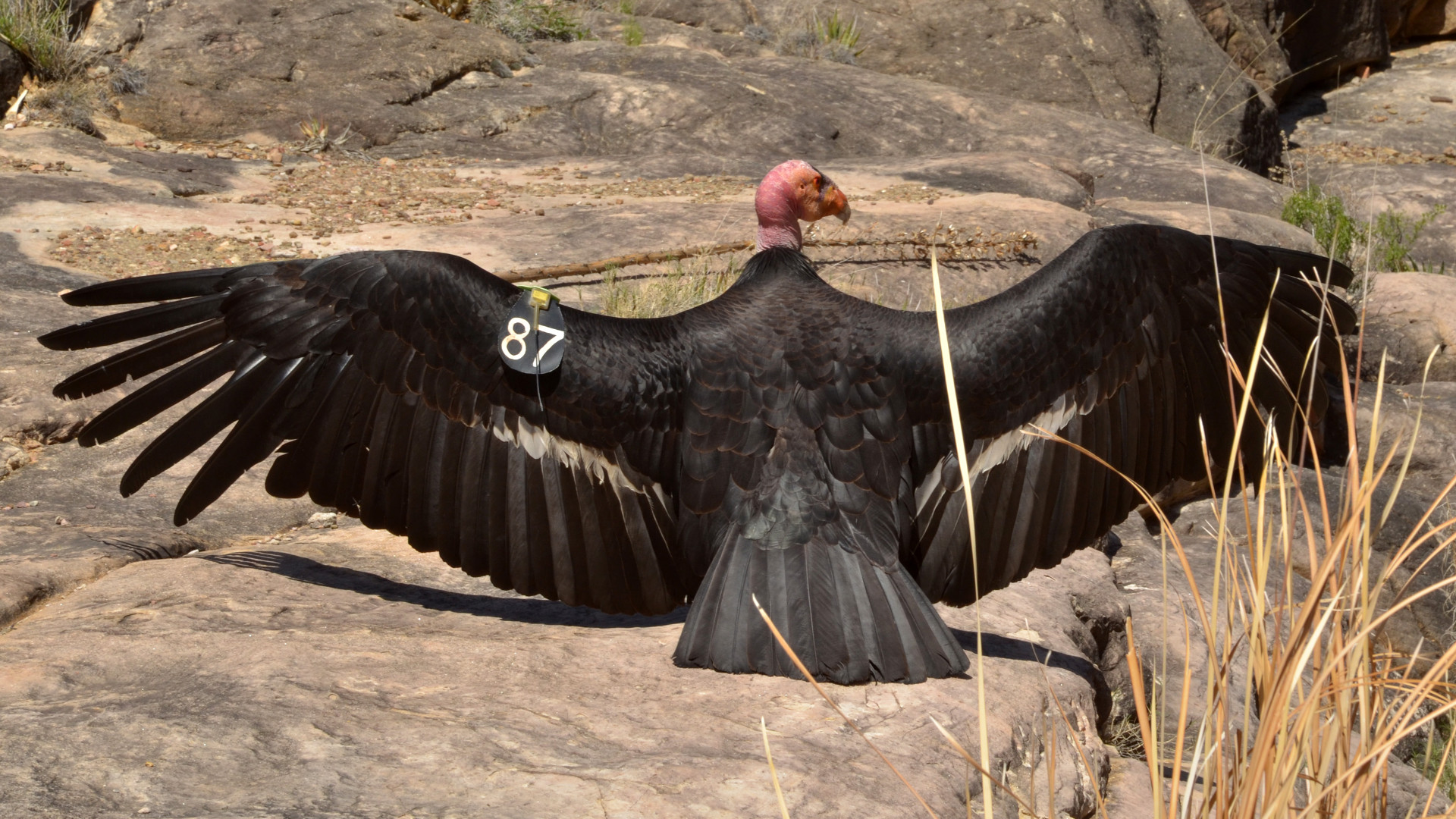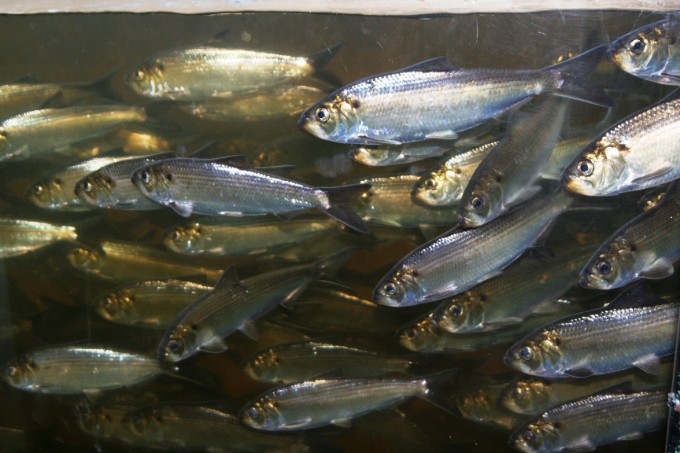
15 Life on Land (152)
Protect, restore and promote sustainable use of terrestrial ecosystems, sustainably manage forests, combat desertification, and halt and reverse land degradation and halt biodiversity loss
Resisting the alien invasion: Oak Ridge work party highlights threat of invasive plants
Written by Ben Pounds Regina Santore with the Wild Ones Smoky Mountains Chapter puts garlic mustard into a bag during an April volunteer event along a greenway in Oak Ridge. Ben Pounds/Hellbender Press
Regina Santore with the Wild Ones Smoky Mountains Chapter puts garlic mustard into a bag during an April volunteer event along a greenway in Oak Ridge. Ben Pounds/Hellbender Press
Volunteers fight exotic and invasive garlic mustard on Oak Ridge greenway
OAK RIDGE — Plants from around the world are overrunning the Southeast’s wild places, causing problems for native flora and fauna.
It’s a problem that’s grabbed the attention and work of dedicated organizations. One of them, the Tennessee Invasive Plant Council has many strategies to solve this problem: volunteer weed-pulling events, guides to help gardeners find native plants from which to choose, and even legislation. Its vice president, Jamie Herold, has many thoughts on the issue. She was eager to share them over pizza after a morning of pulling one such invasive, garlic mustard, at an event in Oak Ridge organized by Tennessee Citizens for Wilderness Planning, and Greenways Oak Ridge.
The event involved pulling garlic mustard, a plant originally from Europe, from the edge of the woods behind apartments on West Vanderbilt Avenue. This area includes the Wildflower Greenway, a trail full of wildflowers that locals have been eager to protect from the garlic mustard’s domination.
- exotic invasive
- exotic species
- invasive plants
- invasive plant control
- invasive species
- oak ridge greenway
- garlic mustard
- tennessee invasive species
- tennessee invasive plant council
- jamie herold
- regina santore
- roger macklin
- wildflower greenway
- tennessee citizens for wilderness planning
- greenways oak ridge
- wild ones smoky mountains chapter
- biodiversity
You feel lucky? Smokies sets synchronous firefly lottery.
GATLINBURG — Great Smoky Mountains National Park will host the annual synchronous firefly viewing opportunity at Elkmont from Monday, June 3 through Monday, June 10. The public may apply for the limited viewing opportunity by entering a lottery for a vehicle reservation through www.recreation.gov.
The lottery opens for reservation applications on Friday, April 26 at 10 a.m. EDT and closes Monday, April 29 at 11:59 p.m. EDT. Using the lottery system ensures everyone who applies for a reservation has an equal chance of getting one.
Want to help wildlife? TWRA to host huge habitat-improvement event

Prepare for a rare period of cicada pandemonium
Written by Stephen Lyn Bales Toward the end of their lives, periodical cicadas emerge from the ground, molt into their adult wardrobe to find each other and reproduce before they die. Periodical cicada nymphs spend their entire 13-year or 17-year lives underground seeking nourishment in roots and slowing growing before time to emerge. Stephen Lyn Bales/Hellbender Press
Toward the end of their lives, periodical cicadas emerge from the ground, molt into their adult wardrobe to find each other and reproduce before they die. Periodical cicada nymphs spend their entire 13-year or 17-year lives underground seeking nourishment in roots and slowing growing before time to emerge. Stephen Lyn Bales/Hellbender Press
Billions upon billions of cicadas will emerge this spring and summer during a rare convergence of broods
Three years ago, Southern Appalachia experienced the emergence of 17-year cicadas’ Brood X. And already, we’re up for another wave of cicadas!
KNOXVILLE — Periodical cicadas are rare. Of the roughly 3,400 cicada species on the planet, only seven of those live underground as nymphs for a staggeringly odd long time.
It gets odder. The seven species are only found in eastern North America, living in 15 separate populations known as “broods.” Some of those broods remain in their subterranean tunnels for 13 years, and some for 17 years.
When their life cycle is up, the strange little insects emerge by the millions to molt into adults and with their new golden wings fly up into the trees where the females and males find each other. They mate, she lays eggs, and then they drop dead.
When the early American colonists moved to their new homeland in the 1600s they were horrified by these oddly spaced natural phenomena. Pilgrims at Plymouth reported them in 1634. With only a sprinkling of education to serve them, they naturally turned to their only field of reference and the stories from the Bible. The New World newbies deemed them to be swarms of locusts from the list of Biblical Plagues beset on Egypt along with water turning to blood, lice, boils, flies, hailstones and the killing of first borns. And why not? To them a bug was a bug, with some more frightening than others.
- cicada in east tennessee
- cicada life stage
- cicada lifecycle
- cicada brood convergence
- cicadas 2024
- what are cicadas?
- thomas jefferson on cicadas
- biblical plagues
- can humans eat cicadas
- cicada recipe
- stephen lyn bales
- scientific american
- orthoptera
- hemiptera
- cicada brood xix and xiii
- university of connecticut biologist john cooley
Observe, upload and preserve during the City Nature Challenge
Written by Thomas Fraser
KNOXVILLE — People across 13 counties in East Tennessee are urged to record animals, plants and fungi they observe for four days in late April.
City Nature Challenge 2024 is international, but the Knoxville-area challenge includes anyone in Anderson, Blount, Campbell, Claiborne, Grainger, Jefferson, Knox, Loudon, Morgan, Roane, Scott, Sevier and Union counties. It will run April 26 through April 29 via the iNaturalist app, which is available on Google play or the App Store. While the focus is largely centered on urban areas, participants don’t have to live within a city or town to record their observations.
Participants can upload photos from a digital camera to the iNaturalist website even if they lack a smartphone. Zoo Knoxville, Tennessee Butterfly Monitoring Challenge, the city of Knoxville, Ijams Nature Center, Sierra Club, South Doyle Middle School and Discover Life in America are partnering to support the project. No experience is needed to participate. Results will be announced on May 6.
Sequoyah Hills is now officially the arboretum we always shared
Written by Ben Pounds Many such new identifying tags highlight trees such as this red cedar in the newly designated Sequoyah Hills Arboretum near Bearden in Knoxville. Ben Pounds/Hellbender Press
Many such new identifying tags highlight trees such as this red cedar in the newly designated Sequoyah Hills Arboretum near Bearden in Knoxville. Ben Pounds/Hellbender Press
The arboretum designation will allow for more extensive tree walks, scout projects, school outings, and other educational programs on the value and beauty of native trees
KNOXVILLE — A small crowd of volunteers with tags and tools descended on Sequoyah Park on a February afternoon, preparing to affix identifying labels to the bark of old trees in one of the city’s most storied neighborhoods.
Sequoyah Park sits along the Tennessee River at 1400 Cherokee Boulevard, tucked behind the Sequoyah Hills neighborhood but open to all who want to run, walk, cycle, or enjoy its open fields and other features. It’s Tennessee Valley Authority land, maintained by the city. The many species of native trees that tower over the park’s long field got recognition this year. The park and other Sequoyah Hills neighborhood areas are now part of the Sequoyah Hills Arboretum, an accredited level one ArbNet arboretum.
Foothills Land Conservancy commits more land to memory
Written by Shelby Lyn Sanders
Generations have crisscrossed the expansive pastures near Cane Creek in Anderson County
Like clockwork, it’s time to scope Sandhill cranes in East Tennessee
Written by Tennessee Wildlife Resources Agency During winter migration, visitors to Hiwassee Wildlife Refuge can view thousands of greater sandhill cranes. Tennessee Wildlife Resources Agency via Appalachian Voices
During winter migration, visitors to Hiwassee Wildlife Refuge can view thousands of greater sandhill cranes. Tennessee Wildlife Resources Agency via Appalachian Voices
Sandhill Crane Festival at Hiwassee Refuge set for Jan. 12-14 in celebration of the crane’s revival and survival
BIRCHWOOD — As many as 12,000 cranes have overwintered at the confluence of the Tennessee and Hiwassee rivers. Whether you’re an avid birder or you’ve never seen a Sandhill crane before, the Tennessee Sandhill Crane Festival represents an extraordinary opportunity to witness a truly unforgettable natural phenomenon.
Experience the migration of the Sandhill cranes and many other waterfowl, eagles, white pelicans and whooping cranes. The entire region buzzes with birds and birdwatchers alike.
The festival will be held from 8 a.m. to 4 p.m. Jan. 12 – 14. Free buses run the short distance from the Birchwood Community Center to the Hiwassee Refuge and Cherokee Removal Memorial. Volunteers are set up at each location for birders and curious visitors alike.
- celebration of cranes
- twra
- hiwassee river
- confluence of the tennessee and hiwassee rivers
- cherokee removal memorial
- sandhill crane
- sandhill crane festival
- sandhill crane recovery
- hiwassee refuge
- john james audubon
- brian fox ellis
- sandhill crane migration
- sandhill crane wintering
- hopin refuge
- meigs county, tn
From Lil Jefe to hellbenders, wild animals inspired hope and validation for the conservation of the world in 2023
Written by Tim Lydon In September, six California condors repeatedly ventured north from their Pinnacles National Park homeland to Mount Diablo in the San Francisco Bay area, becoming the first condors seen in that area in over a century. Biologists speculate the sorties may indicate new nesting territories. Seen here is a condor deemed California condor 87 by biologists tracking the rare bird population. Michael Quinn/National Park Service
In September, six California condors repeatedly ventured north from their Pinnacles National Park homeland to Mount Diablo in the San Francisco Bay area, becoming the first condors seen in that area in over a century. Biologists speculate the sorties may indicate new nesting territories. Seen here is a condor deemed California condor 87 by biologists tracking the rare bird population. Michael Quinn/National Park Service
Rare and threatened animals used innate skills and courage to recover lost territory, expand their ranges, or simply survive against the odds. Humans helped.
It’s tradition to honor the past year’s human achievements. From peacemakers and scientists to athletes and artists, we celebrate those who inspire us. But what about the wildlife who surround us who make up the biodiversity that sustains us? Each year standout members of those populations also set records and push boundaries, many with lasting results.
Consider P-22, also known as the “Hollywood cat.” In 2012 this young mountain lion surprised biologists and captured hearts by establishing a decade-long residency in the Griffith Park area of Los Angeles. Stealthily threading through backyards and freeways, he demonstrated the value of landscape connectivity, even in urban areas. And though he died in 2022, he inspired a massive fundraising campaign that helped build the largest wildlife bridge in the United States, to be completed in 2025 over California’s 10-lane Highway 101. In this way he changed the world.
- wildlife conservation
- ozark hellbender
- california condor
- tim lydon
- the revelator
- prince william sound stewardship foundation
- hollywood cat
- mountain lions
- ocelots
- grizzlies on the great plains
- endangered species act
- missouri river breaks
- wolverines endangered species act
- american prairie
- wolves in southern sierras
- flamingos
- hurricane flamingoes
- huachuca mountains
- saint louis zoo
- okaloosa darter
The Revelator: 10 ways targeted dam removals can help solve the climate change dilemma
Written by Gary Wockner Alewives returned by the millions after the Edwards and Ft. Halifax dams were removed in Maine. John Burrows/ASF via The Revelator
Alewives returned by the millions after the Edwards and Ft. Halifax dams were removed in Maine. John Burrows/ASF via The Revelator
By providing both mitigation and adaption, dam removal can lower greenhouse gas emissions and restore carbon sinks.
This article was originally published in The Revelator. Gary Wockner
As the climate crisis escalates, a huge amount of attention and money is being focused on climate solutions.
These can be divided into two categories: solutions that pursue “mitigation,” which lowers greenhouse gas emissions, and those that pursue methods to adapt to climate impacts to increase human and ecological resiliency.
Dams, of course, create enormous environmental harms, many of which have already been described in scientific literature. Equally well documented is the fact that removing dams can restore seriously damaged ecosystems. But missing from almost every climate-solution story and study is how dam removal can be key for both mitigation and adaptation.
Here are 10 reasons how dam removal fights climate change.
- climate action
- dam removal
- the revelator
- gary wockner
- greenhouse gas emission
- methane emission
- natural flow of the river
- river plume
- carbon sink
- reservoir
- biodiversity
- sediment transport
- fish population dynamic
- water supply
- reservoir evaporation
- climate resilience
- heat island
- forest cooling effect
- river cooling effect
- climate crisis
- lake mead water level
- colorado river water restriction
More...
Meet the salamanders making the South a biodiversity hotspot
Written by Southern Environmental Law CenterSkip to main co An eastern newt in its juvenile stage in Blacksburg, Virginia. Courtesy SELC.
An eastern newt in its juvenile stage in Blacksburg, Virginia. Courtesy SELC.
Salamanders are under siege in a changing world
Salamanders are extraordinary creatures. Some of these astonishing amphibians boast vibrant colors and patterns while two-thirds of all species are lungless and able to breathe through their skin. All salamanders have the remarkable ability to regrow limbs, tails, and even parts of their heart and brain, a rare ability in the animal kingdom.
More salamander species live in the Appalachians than anywhere else in the world. Fifty-four species of salamander call Virginia home.
Roughly 20 percent of the world’s salamander species can be found in the South
Unfortunately, the impacts of climate change, habitat loss and pollution pose a real danger to these sensitive creatures. Increased temperatures, changing humidity levels, wildfires and droughts wreak havoc on salamanders, which are impacted by even small changes in habitat conditions and are often specialized to small native ranges.
Southern Environmental Law Center’s work addressing climate change, fighting for clean water, and conservation efforts help protect all kinds of salamanders in the South. To celebrate the Endangered Species Act’s 50th anniversary, they are highlighting some of the endangered and threatened salamanders of our region.
50th anniversary of the Endangered Species Act
Written by Southern Environmental Law Center
For decades, the Endangered Species Act has served valuable in preserving species and making our region so unique
Dec. 28 marks the 50th anniversary of the Endangered Species Act — an important legal tool for protecting imperiled Southern species and their habitat. Since its passage in 1973, we’ve seen a nearly 99 percent success rate in preventing the loss of animals and plants protected under the law, including the iconic bald eagle and American alligator.
The Endangered Species Act establishes protections for fish, wildlife and plants that are listed as threatened or endangered; provides for adding species to and removing them from the list of threatened and endangered species, and for preparing and implementing plans for their recovery; provides for interagency cooperation to avoid take of listed species and for issuing permits for otherwise prohibited activities; provides for cooperation with States, including authorization of financial assistance; and implements the provisions of the Convention on International Trade in Endangered Species of Wild Flora and Fauna.
This bedrock environmental law reminds us there is still more work to do to protect the South’s rich biodiversity — including fighting in court to save at-risk species, advocating for more protective regulations, and defending the Endangered Species Act.
Join a community of Tennesseans carving out gardens to attract, feed and nurture pollinating wildlife
 These signs will show your friends and neighbors that your wildflower garden supports pollinators and hopefully get them excited about starting a pollinator garden too! Our original signs are made from embossed, recycled aluminum and measure 8 x 12 inches. They are available for a donation of $25 each and can be shipped directly to you. Tennessee Environmental Council
These signs will show your friends and neighbors that your wildflower garden supports pollinators and hopefully get them excited about starting a pollinator garden too! Our original signs are made from embossed, recycled aluminum and measure 8 x 12 inches. They are available for a donation of $25 each and can be shipped directly to you. Tennessee Environmental Council
Through Generate Some Buzz, the Tennessee Environmental Council aims to engage hundreds of Tennesseans in establishing new pollinator habitats statewide. All gardens, both big and small are welcome and by participating in this program, you are joining a vibrant community of Tennesseans committed to protecting our pollinators, one plot at a time.
Populations of many pollinator species like bees, butterflies, moths, beetles and hummingbirds have been negatively impacted by agricultural practices such as using synthetic pesticides, disease and habitat loss. These creatures are experiencing a drastically different world compared to just a few decades ago.
Native pollinators depend on native plants to provide habitat and food, and plants need pollinators to help them reproduce. In fact, pollinators assist in the reproduction of 75 percent of flowering plants worldwide. Turning manicured lawns that provide little to nothing for pollinators into havens full of native flowers and wild grasses, we will effectively "Generate Some Buzz" and bring back these essential workers full force.

Study expounds upon evolution of mosquitoes and their hosts

This story was originally published on Phys.org and authored by Mick Kulikowski, Director of Strategic Communications and Media Relations at NC State University
Raleigh, NC — Researchers at North Carolina State University and global collaborators have mapped the mosquito’s tree of life, a major step toward understanding important traits, such as how the insects choose their hosts, feed on blood and spread disease. The findings will help researchers make better predictions to model disease transmission and understand what makes some mosquitoes better disease carriers than others.
The research suggests mosquito evolution over the past 200 million years mirrors the Earth’s history of shifting land masses and changing host organisms, said Dr. Brian Wiegmann, William Neal Reynolds Professor of Entomology at NC State and corresponding author of a paper describing the mosquito family tree.
The William Neal Reynolds Professorship is one of the highest distinctions available to NCSU faculty members.The Reynolds Professorships were established in 1950 by William Neal Reynolds, a long-time president and board chairman of the R.J. Reynolds Tobacco Company, to recognize and support outstanding faculty achievement in research, teaching and extension.
“This ongoing project builds a big-data resource that mines the academic literature with published observations of the sources of blood mosquitoes drink, from animals as diverse as fish to humans,” Wiegmann said. “It focuses explicitly on data collection to infer aspects of mosquito biology in a contextualized way. That means linking up the family, or phylogenetic, tree with the narrative of life on Earth: geologic history, climate history and organism history.”